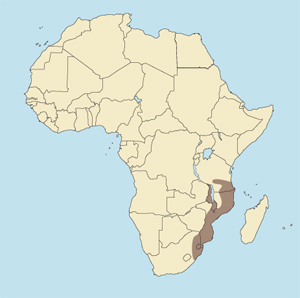 |
Cephalophus natalensis
Duiquer rojo (Sp), Natalducker, Rotducker (G), Céphalophe de Natal (F), Rooiduiker (Af).
DESCRIPTION Shoulder height 17-18 inches (43-46 cm). Weight 25-30 pounds (11-14 kg).
The Natal red duiker is a relatively small duiker with a uniformly bright chestnut color and somewhat paler underparts. There is a tuft of long hairs on the head, which is usually chestnut and black, but is sometimes just chestnut. The chin and throat are whitish. The tail is reddish with a black and white tuft. The horns (both sexes) are thick and short, cone-shaped, strongly ridged at the base, and grow backward in the plane of the face. Females are similar to males, but are a little larger and have smaller horns.
BEHAVIOR More diurnal and less secretive than most forest duikers, thus more readily observed. Lives singly, in pairs, or in small family groups. Has lived as long as 15 years in captivity.
HABITAT Dense bush and forest.
DISTRIBUTION Southeastern Tanzania, including the Selous Reserve; Malawi; the Nyika area of extreme northeastern Zambia; Mozambique; possibly in southeastern Zimbabwe; Swaziland; and the eastern Transvaal and Natal in South Africa.
TAXONOMIC NOTES Includes these races: amoenus (Transvaal), lebombo (northeastern Natal), natalensis (southern Natal), robertsi (Mozambique and north to southeastern Tanzania), and walkeri (Malawi).
PLEASE NOTE Misclassification has sometimes been a problem with this animal. Several "Natal red duikers" entered for the Record Book from South Africa have turned out, on examination, to be young bush duikers. The two species actually are very different in appearance. Hunters are advised to learn what a red duiker looks like before they hunt it.
|





